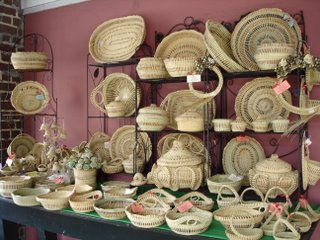
My favorite part of our visit to Charleston was walking through the Market and watching the ladies make sweetgrass baskets. Sweetgrass basket making has existed in the South Carolina Lowcountry for more than 300 years. This traditional art form was brought to this area by the slaves who came from West Africa. Since then it has been passed down from generation to generation, usually from mother to daughter to granddaughter, though the whole family is often involved. Traditionally the men gather the materials (sweetgrass, longleaf pine needles, bulrush and palmetto leaves) and the women "sew" the baskets.
It is fascinating to watch the basketmaker "sew" her basket. The tools of the trade (other than the natural materials) include a pair of scissors and a "nailbone". A nailbone is used for piercing when making a sweetgrass basket. In the old days a rib bone from a cow or pig was filed down for this. Today most basketmakers use a filed down silver spoon or fork or even a nail.

Each basket begins about the same with a coiled circular or oval shaped bottom, but can become one of a hundred or more styles. A small basket of a simple design can take up to twelve hours to complete, while a larger complex design can take months.
I knew I wanted to buy a basket to take home. I walked through the whole market before deciding to buy a basket from Sue Middleton.

Something about her baskets caught my eye. They are beautifully made and the coils are very uniform and tightly sewn--the work of an experienced basketmaker. I finally decided to buy a round bread basket that incorporated all of the materials in it's design.

The lightest color in this basket is sweetgrass. By the way, it is called this because of it's pleasant fragrance, similar to fresh cut hay. The brown color is pine needle and the black is bulrush. The coils are sewn together with strips of palmetto leaves.

Though sweetgrass baskets are expensive, I don't think the basketmakers are getting rich from this business. They make baskets because they love to and because they don't want this part of their heritage to die out.
I found these quotes made by sweetgrass basketmakers from this article:
Maggie Polite Manigault makes baskets "because she has been doing it for so long that she would feel lost if she didn't sew at least once a day."
"Even though basketweaving is time consuming," says Mae Bell Coakley, "I enjoy it because it's relaxing, kind of therapy."
"Making things with your hands keeps your head together," Mary Jane Manigault reflects. "When you sew baskets, you just concentrate on that one thing. You have to have long patience. You can't be a nervous somebody and make baskets. You have to sit in one place and really get into what you are doing. You can't have your mind running on all kind of different things. You have to have a settled mind."
Sounds a lot like knitting, doesn't it?
Beautiful baskets! I make regular woven baskets, so I can appreciate all of the work that goes into one of these baskets.....just lovely!
ReplyDeleteWow, that is a super story. Gee, too bad you couldn't have taken orders for the rest of us. They make great places to store yarn and knitting supplies.
ReplyDeleteThey are gorgeous! It'd be a shame to put something in there and cover up the inside.
ReplyDeleteHow beautiful! I love her coils around the top. We have an abundant supply of long pine needles here and I have tried my hand at those, but I'm totally a novice. It's something I would like to do more of.
ReplyDeleteThose are so beautiful.
ReplyDeleteAs I read that I thought, "sounds like knitting", and then I read that you thought the same thing. Funny.
Totally GORGEOUS!!! I love handmade things and the history behind their making makes them that more of a treasure. Thanks for sharing such a lovely story:D
ReplyDeleteWhat a great post! I just love the basket you picked out. I am a basket addict, LOL. I have them all over the house, most stuffed with yarn or fiber, LOL. I'm glad you had a great trip.
ReplyDeletestunning basket. A beautiful city too. I'm glad you had a nice trip. :)
ReplyDeleteI would have stood there all day trying to make up my mind about which one to buy. You made a nice choice:o)
ReplyDeleteBeautiful baskets...I must have one. Thanks for sharing the story.
ReplyDeleteI love sweetgrass...i have some in my yard just for the scent. I was surprised to see it as an African tradition; it's also a very Native tradition on the prairies and plains of America.
ReplyDeleteI have just recently started making sweet grass baskets, the sweet grass collected along the Bay of Funday is n NS. It wasn't till me third basket that I realize I was making them from the inside out. Watched no a mi Omar basket maker I realized what is was doing wrong. I also realize now looking at the baskets above that their coils are much wider. I have been using Strands of four so my baskets are fine.
ReplyDeleteI bet every basketmaker has their own technique. I think I've seen tiny baskets made with thinner coils--very delicate and pretty. I'm not sure if the thickness of the coils has anything to do with strength of the basket or if it's just a design choice. Good luck making your baskets!
DeleteIt should read Mi Kmaw basket maker.
ReplyDelete